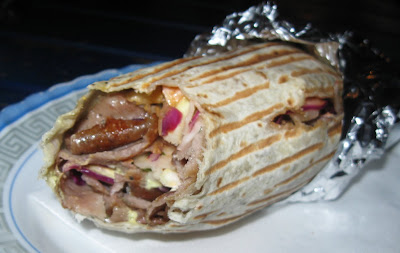Ramadan?

No. Get your lunar and solar calenders straight. It is pretty lonely during the day in these Turkish restaurants in Berlin though. I am keeping my position on döner no matter what kendi says. This is from a place called Imren in a Turkish part of Kruezberg, which is supposed to have the best dürüm döner. It is still just not that good.

They do have other good middle eastern food here though. There are a lot of vegetarians so you can get stuff like this. This is from a place called knofi which is very popular and has dozens of spreads to choose from.

So, what does summer mean? Fried chicken?

No again. They love chicken in Berlin. This place is called Henne and is wildly popular, but it isn't a seasonal thing. I thought it was very overrated btw.

Does it mean public nudity?

This is a diorama from a museum on East Germany that claims nearly everyone went on nudist holidays. I still saw it in evidence today as men were completely nude in the public park the Tiergarten. However, this can´t be the answer because as readers of this blog know I am too shy to take photos of fully nude strange men (in public at least).
Does it mean recreational boating?

No again. I was obviously taking a picture not of the boatists but of the marker for the spot where the founder of German Communism was thrown into a canal after being murdered with rifle butts to the head by government supported right wing militias in 1919. It is nice to see these people are not letting that bring them down and are enjoying a nice sunny afternoon.
Does it mean smoked fish sandwiches?

Another popular berlin treat, but I think that is more of a winter snack.
How about spicy food?

This is seemingly the most popular currywurst place in Berlin. But, I should have pointed out before that the currywurst isn't really spicy. They just dump more chilly powder on it if you want, before they cover it in what seems like ketchup.

Sorry you can see more the fries here but the sausage is covered in ketchup anyway.
No, summer in Berlin is obviously all about the girly beer cocktails.


I didn´t put it in my gose, but in Berlin they don't give you a choice. The beer here is so bad that to have something interesting you have to resort to the raspberry (red) or woodruff (green) syrup. The beer they put it in is actually pretty good. It is called Berliner Weisse and is sour and not like any weissebeir you would get in Bavaria. It isn't all that sour, but no one drinks it straight. You can´t even get it that way unless you are prepared to fight with the waiter in german. I did drink a few bottles of it while I wrote this blog though. It is only made by one company, Kindl, and only comes in bottles. Also, if you want to get really girly you can put blue curacao or even coke into it. I didn´t.
Speaking of girly, if I needed one image to wrap up the absurdity that the theme of this blog gets me into. Here it is.
Click on it if you can't read the tattoo.

This woman is running on the far left ticket for parliament. I originally thought it came off as sexist, until I realized it was her real picture. Now I have no idea what to think. The slogan is "pants full of arse in the parliament". That is an idiom in german that means boldness. At least it isn't as boring as all the posters with the people's faces on them. Regardless, I think the socialists are making great campaign choices in this largely muslim district.
 This is their favorite summer activity, driving their husvagn (camper) to a big trailer park in the countryside and spending weeks with their family. Even though the whole countryside is open and you are able to camp on any land, even private land, as long as you don't disturb the owner, people prefer these crowded sites.
This is their favorite summer activity, driving their husvagn (camper) to a big trailer park in the countryside and spending weeks with their family. Even though the whole countryside is open and you are able to camp on any land, even private land, as long as you don't disturb the owner, people prefer these crowded sites. This is called snus. The guy next to me on the plane dipped it the whole flight back. That tool is called a prismaster. He used it to get the right size and shape dip. I didn't realize he was dipping until he took out the prismaster, because they don't spit. They swallow the juice. Even the most backwoods country boy in Texas wouldn't do that. Here is the selection, I don't see Copenhagen or Skoal but I see where they get their names.
This is called snus. The guy next to me on the plane dipped it the whole flight back. That tool is called a prismaster. He used it to get the right size and shape dip. I didn't realize he was dipping until he took out the prismaster, because they don't spit. They swallow the juice. Even the most backwoods country boy in Texas wouldn't do that. Here is the selection, I don't see Copenhagen or Skoal but I see where they get their names. And what do they really eat here? Here it is, the real national dish of Sweden. Korv.
And what do they really eat here? Here it is, the real national dish of Sweden. Korv. It comes complete with ketchup, mustard and dried onions. It is terrible. The swedes go crazy for it.
It comes complete with ketchup, mustard and dried onions. It is terrible. The swedes go crazy for it.
















































